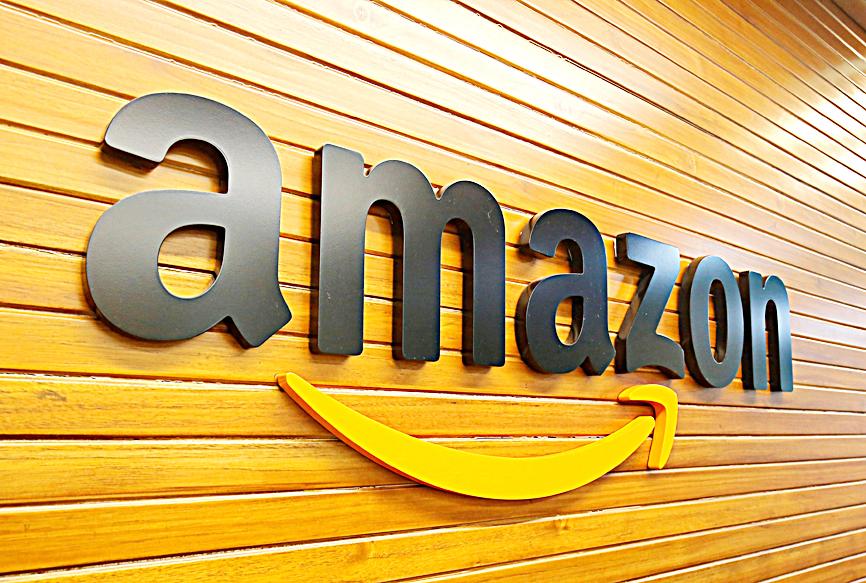Amazon.com Inc is to begin making devices in India for the first time, joining a flock of technology companies setting up manufacturing operations in the country.
The Seattle-based e-commerce giant would start making the devices via a subsidiary of its manufacturing partner, Hon Hai Precision Industry Co (鴻海精密) — known as Foxconn Technology Group (富士康科技集團) outside of Taiwan — with production starting later this year in its facilities outside Chennai, the company said in a blog post yesterday.
“The device manufacturing program will be able to produce hundreds of thousands of Fire TV Stick devices every year, catering to the demands of customers in India,” the company said. “Amazon will continuously evaluate scaling capacity to additional marketplaces.”

Photo: Reuters
The online retailer is joining electronics giants such as Apple Inc and Samsung Electronics Co in making devices such as smartphones and tablets in the nation.
Yesterday, Amazon India vice president and country manager Amit Agarwal briefed Indian Minister of Electronics and Information Technology Ravi Shankar Prasad on the details of the company’s manufacturing plans, as it reiterated its commitment to the government’s “Make in India” push.
Amazon has deep roots in India, with founder Jeff Bezos pledging to build one of his biggest e-commerce operations outside of the US in the country, but the company’s expansion into a retail market worth an estimated US$1 trillion has hit hurdles and it is currently locked in a legal battle over the sale of Mumbai-based Future Group’s assets to billionaire Mukesh Ambani’s Reliance Industries Ltd.
With its latest manufacturing program, Amazon is signaling that it is digging its heels in.
The company had earlier pledged to invest US$1 billion to digitize 10 million small and medium businesses, to help Indian companies export US$10 billion of goods and to create an additional 1 million jobs by 2025.
Conservative social media website Parler has returned to the internet after its service provider suspended the site in the wake of the Jan. 6 riot at the U.S. Capitol.
Meanwhile, a toxic-dust cocktail that has engulfed large swathes of India since October is not expected to lift until next month, prolonging the exposure of people to emissions that can dramatically reduce their lifespan.
This week’s forecast by the Copernicus Climate Change Service follows a new study by scientists at Harvard University showing that about 2.5 million Indians die annually from air pollution.
Smog season recurs yearly in cities like New Delhi, as burning farmland combines with fossil-fuel exhaust, enveloping urban centers during cold months when demand for heat is high and air circulation is muted.
“This winter haze could potentially continue until the spring when increased temperature and changes in the weather will help to dissipate the pollution,” said Mark Parrington, a senior scientist at Copernicus.
The danger arises from “activities such as traffic, cooking, heating and crop stubble burning which are able to accumulate over the region due to topography and cold stagnant conditions,” Parrington added.
The Harvard study published this month in Environmental Research concluded that previous estimates of deaths caused by long-term exposure to airborne toxic particles were too low.
“By quantifying the health consequences of fossil-fuel combustion, we can send a clear message to policymakers and stakeholders of the benefits of a transition to alternative energy sources,” author Joel Schwartz said in a statement.

Application-specific integrated circuit designer Faraday Technology Corp (智原) yesterday said that although revenue this quarter would decline 30 percent from last quarter, it retained its full-year forecast of revenue growth of 100 percent. The company attributed the quarterly drop to a slowdown in customers’ production of chips using Faraday’s advanced packaging technology. The company is still confident about its revenue growth this year, given its strong “design-win” — or the projects it won to help customers design their chips, Faraday president Steve Wang (王國雍) told an online earnings conference. “The design-win this year is better than we expected. We believe we will win

Intel Corp chief executive officer Lip-Bu Tan (陳立武) is expected to meet with Taiwanese suppliers next month in conjunction with the opening of the Computex Taipei trade show, supply chain sources said on Monday. The visit, the first for Tan to Taiwan since assuming his new post last month, would be aimed at enhancing Intel’s ties with suppliers in Taiwan as he attempts to help turn around the struggling US chipmaker, the sources said. Tan is to hold a banquet to celebrate Intel’s 40-year presence in Taiwan before Computex opens on May 20 and invite dozens of Taiwanese suppliers to exchange views

Chizuko Kimura has become the first female sushi chef in the world to win a Michelin star, fulfilling a promise she made to her dying husband to continue his legacy. The 54-year-old Japanese chef regained the Michelin star her late husband, Shunei Kimura, won three years ago for their Sushi Shunei restaurant in Paris. For Shunei Kimura, the star was a dream come true. However, the joy was short-lived. He died from cancer just three months later in June 2022. He was 65. The following year, the restaurant in the heart of Montmartre lost its star rating. Chizuko Kimura insisted that the new star is still down

While China’s leaders use their economic and political might to fight US President Donald Trump’s trade war “to the end,” its army of social media soldiers are embarking on a more humorous campaign online. Trump’s tariff blitz has seen Washington and Beijing impose eye-watering duties on imports from the other, fanning a standoff between the economic superpowers that has sparked global recession fears and sent markets into a tailspin. Trump says his policy is a response to years of being “ripped off” by other countries and aims to bring manufacturing to the US, forcing companies to employ US workers. However, China’s online warriors